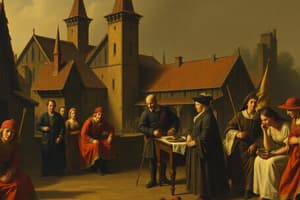Podcast
Questions and Answers
In a feudal system, lords granted land to peasants in exchange for loyalty and military service.
In a feudal system, lords granted land to peasants in exchange for loyalty and military service.
False (B)
The Church played a minor role in the feudal system, owning little land and having limited political influence.
The Church played a minor role in the feudal system, owning little land and having limited political influence.
False (B)
Feudalism created a flexible social hierarchy with opportunities for social mobility.
Feudalism created a flexible social hierarchy with opportunities for social mobility.
False (B)
Medieval Europe was characterized by a strong centralized authority with a single ruler.
Medieval Europe was characterized by a strong centralized authority with a single ruler.
Merchants and artisans were the dominant social class in Medieval Europe.
Merchants and artisans were the dominant social class in Medieval Europe.
The Black Death pandemic occurred in the 16th century.
The Black Death pandemic occurred in the 16th century.
Chivalry and courtly love emerged in ancient Greece.
Chivalry and courtly love emerged in ancient Greece.
The Crusades were a series of religious wars between Christians and Muslims that took place in the 17th century.
The Crusades were a series of religious wars between Christians and Muslims that took place in the 17th century.
Flashcards are hidden until you start studying
Study Notes
Feudalism
- Definition: A social and economic system in which lords owned land and peasants worked it in exchange for protection and security.
- Characteristics:
- Hierarchical structure: King → Nobles → Vassals → Peasants
- Lords granted land (fiefs) to vassals in exchange for loyalty, military service, and tribute
- Peasants worked the land and provided goods and services to lords
- Role of the Church:
- Provided spiritual guidance and legitimacy to the feudal system
- Owned land and exercised significant political influence
- Impact on society:
- Created a rigid social hierarchy with limited social mobility
- Fostered localism and decentralization of power
- Limited economic growth and innovation
Medieval Europe
- Timeline: Approximately 500-1500 CE
- Key features:
- Fragmented political landscape: numerous kingdoms, duchies, and city-states
- Limited centralized authority: power held by local lords and nobles
- Agricultural economy: mainly focused on subsistence farming
- Social classes:
- Nobility: held power and land, engaged in warfare and governance
- Clergy: provided spiritual guidance, education, and administrative services
- Peasants: worked the land, provided goods and services to lords
- Merchants and artisans: engaged in trade, commerce, and crafts
- Cultural achievements:
- Development of chivalry and courtly love
- Emergence of universities and scholasticism
- Construction of cathedrals, castles, and monasteries
- Challenges and conflicts:
- Frequent wars and battles over land and power
- Black Death pandemic (1346-1353 CE): significant population decline
- Crusades: series of religious wars between Christians and Muslims
Feudalism
- A social and economic system where lords owned land, and peasants worked it in exchange for protection and security, characterized by a hierarchical structure.
- King → Nobles → Vassals → Peasants: the social hierarchy, with each level owing loyalty and services to the one above.
- Lords granted land (fiefs) to vassals in exchange for loyalty, military service, and tribute, while peasants worked the land and provided goods and services to lords.
- The Church played a crucial role, providing spiritual guidance and legitimacy to the feudal system, and owning land, exercising significant political influence.
Medieval Europe
- Lasted from approximately 500-1500 CE, marked by a fragmented political landscape with numerous kingdoms, duchies, and city-states.
- Limited centralized authority, with power held by local lords and nobles, and an agricultural economy focused on subsistence farming.
- Social classes consisted of:
- Nobility: held power and land, engaged in warfare and governance.
- Clergy: provided spiritual guidance, education, and administrative services.
- Peasants: worked the land, providing goods and services to lords.
- Merchants and artisans: engaged in trade, commerce, and crafts.
- Cultural achievements included:
- Development of chivalry and courtly love.
- Emergence of universities and scholasticism.
- Construction of cathedrals, castles, and monasteries.
- Challenges and conflicts included:
- Frequent wars and battles over land and power.
- The Black Death pandemic (1346-1353 CE): a significant population decline.
- Crusades: a series of religious wars between Christians and Muslims.
Studying That Suits You
Use AI to generate personalized quizzes and flashcards to suit your learning preferences.




